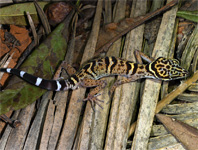Abstract
We describe four new species of the diving beetle genus Liodessus Guignot from the high Andean regions of Peru: Liodessus alpinus sp. nov. from Junín, L. hauthi sp. nov. from Huánuco and Churubamba, L. rhigos sp. nov. from Junín, and L. thespesios sp. nov. from Cusco. We delineate the species using morphological structures and provide a 5’ mitochondrial cytochrome c oxidase 1 database on the Barcode of Life Data System (BOLD). We also provide taxonomic notes on Liodessus acollensis Guignot, 1955 and L. andinus Guignot, 1957, described from the high Andes of Peru and Bolivia. These species occur at higher altitudes above 3,400 m and up to 4,900 m, and were collected in shallow, exposed peatland pools and puddles, mostly in steppes and high Andean Puna. The known distribution and habitat preferences of each species are outlined briefly.
References
Balke, M., Bergsten, J., Wang, L.J. & Hendrich, L. (2017) A new genus and two new species of Southeast Asian Bidessini as well as new synonyms for Oceanian species (Coleoptera, Dytiscidae). Zookeys, 647, 137–151.
https://doi.org/10.3897/zookeys.647.11231
Balke, M., Ospina-Torres, R., Suarez-Megna, Y. & Hendrich, L. (2020a) Liodessus lacunaviridis sp. n. from the high Andes of Colombia (Coleoptera: Dytiscidae: Hydroporinae: Bidessini). Tijdschrift voor Entomologie, 1–5. [published online]
https://doi.org/10.1163/22119434-20192084
Balke, M., Megna, Y.S., Zenteno, N., Figueroa, L. & Hendrich, L. (2020b) Two new species of Liodessus Guignot, 1939 diving beetles from Northern Peru (Coleoptera, Dytiscidae, Hydroporinae). Alpine Entomology 4, 173–178.
https://doi.org/10.3897/alpento.4.55139
Biström, O. (1988) Generic review of the Bidessini (Coleoptera, Dytiscidae). Contribution to the study of Dytiscidae 37. Acta Zoologica Fennica, 184, 1–41.
Brown, R.W. (1956) Composition of scientific words. Revised Edition. Smithsonian Books, Washington, D.C., 814 pp.
Guignot, F. (1955) Quarante-deuxième note sur les hydrocanthares. Revue Française d’Entomologie, 22, 270–276.
Guignot, F. (1957) Beiträge zur Kenntnis der Insektenfauna Boliviens. Teil II. Coleoptera. I. Dytiscidae (2. Contribution à l’étude des dytiscides sudaméricains). Opuscula Zoologica, 6, 1–10.
Hawlitschek, O., Hendrich, L., Espeland, M., Toussaint, E.F., Genner, M.J. & Balke, M. (2012) Pleistocene climate change promoted rapid diversification of aquatic invertebrates in Southeast Australia. BMC Evolutionary Biology, 12, 142.
https://doi.org/10.1186/1471-2148-12-142.
Hebert, P.D., Cywinska, A., Ball, S.L. & Dewaard, J.R. (2003) Biological identifications through DNA barcodes. Proceedings of the Royal Society of London. Series B: Biological Sciences, 270, 313–321.
https://doi.org/10.1098/rspb.2002.2218.
Hendrich, L., Pons, J., Ribera, I. & Balke, M. (2010) Mitochondrial cox1 sequence data reliably uncover patterns of insect diversity but suffer from high lineage-idiosyncratic error rates. PLoS One, 5, e14448.
https://doi.org/10.1371/journal.pone.0014448
Kwong, S., Srivathsan, A., Vaidya, G. & Meier, R. (2012) Is the COI barcoding gene involved in speciation through intergenomic conflict? Molecular Phylogenetics and Evolution, 62, 1009–1012.
https://doi.org/10.1016/j.ympev.2011.11.034
Lam, A.W., Gueuning, M., Kindler, C., Van Dam, M., Alvarez, N., Panjaitan, R., Shaverdo, H., White, L.T., Roderick, G.K. & Balke, M. (2018) Phylogeography and population genomics of a lotic water beetle across a complex tropical landscape. Molecular Ecology, 27, 3346–3356.
https://doi.org/10.1111/mec.14796
Megna, Y. S., Hendrich, L., García-Hernández, A. L., Ospina-Torres, R., Prieto, C. & Balke, M. (2019) Diving beetles of the genus Liodessus Guignot, 1953 in Colombia, with description of three new species (Coleoptera: Dytiscidae). Aquatic Insects, 40, 99–122.
https://doi.org/10.1080/01650424.2018.1538521
Miller, K.B. & Bergsten, J. (2016) Diving beetles of the world: Systematics and biology of the Dytiscidae. Johns Hopkins University Press, Baltimore, Maryland, ix + 320 pp.
Nilsson, A. & Hájek, J. (2020) A world catalogue of the family Dytiscidae, or the diving beetles (Coleoptera, Adephaga). Version 1. I. 2020. Distributed as a PDF file via Internet. Available from: http://www.waterbeetles.eu/documents/W_CAT_Dytiscidae_2020.pdf (accessed 24 August 2020)
Ratnasingham, S. & Hebert, P. D. (2007) BOLD: The Barcode of Life Data System (http://www.barcodinglife.org). Molecular Ecology Notes, 7, 355–364.


